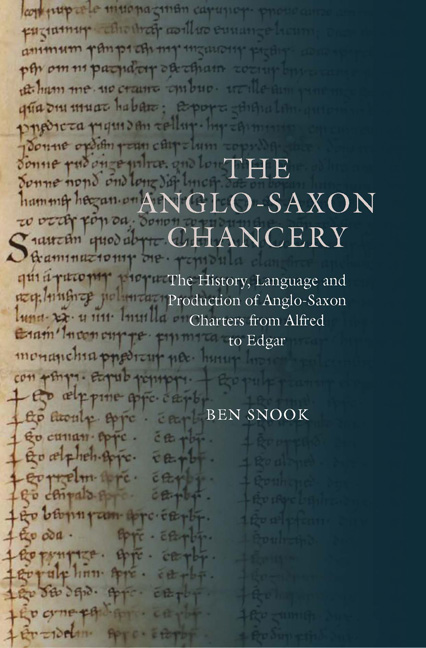 The Anglo-Saxon Chancery
The Anglo-Saxon Chancery Book contents
- Frontmatter
- Epigraph
- Contents
- Acknowledgements
- list of Abbreviations
- Timeline of Key Events between the Accession of Alfred and the Death of Edgar
- Introduction
- 1 Brave New World: The Charters of Alfred and Edward
- 2 Æthelstan
- 3 ‘Æthelstan A’
- 4 Turbulent Priests: Dunstan, Cenwald and Oda
- 5 Back to the Future: Edgar and ‘Edgar A’
- Conclusion
- Appendix I S 193
- Appendix II S 346
- Appendix III S 225
- Bibliography
- Index of charters
- Index
5 - Back to the Future: Edgar and ‘Edgar A’
Published online by Cambridge University Press: 05 May 2015
- Frontmatter
- Epigraph
- Contents
- Acknowledgements
- list of Abbreviations
- Timeline of Key Events between the Accession of Alfred and the Death of Edgar
- Introduction
- 1 Brave New World: The Charters of Alfred and Edward
- 2 Æthelstan
- 3 ‘Æthelstan A’
- 4 Turbulent Priests: Dunstan, Cenwald and Oda
- 5 Back to the Future: Edgar and ‘Edgar A’
- Conclusion
- Appendix I S 193
- Appendix II S 346
- Appendix III S 225
- Bibliography
- Index of charters
- Index
Summary
In many ways, edgar's reign can be seen as the high-water mark of the whole Anglo-Saxon age. From the infighting that had fractured English politics in the 950s, Edgar emerged as a force for unity under whose judicious guidance art, literature, scholarship and scribal culture flourished throughout England. Edgar ‘the peaceable’, as he later became known, has been seen by many as the archetypal medieval king: pious, wise, firm, fair and scholarly, his virtues were apparently legion.
Except, of course, that they almost certainly were not. The main reason why Edgar is remembered as such a fine king is that most of what was written about him during his reign flowed from the pens of the monastic reformers and their sympathisers, of whom edgar was an enthusiastic and generous patron. In reality, the fierce backlash against reformed monasticism after Edgar's death, the murder of Edward, his son and successor in 978, and the rapidity with which the Anglo-Saxon state disintegrated into chaos during the reign of Æthelred ‘the Unready’ suggest strongly that the politicking, intrigue and factionalism of the 950s had, at best, been brushed under the carpet by edgar and the reformers.
On account of these competing views of edgar, his charters are all the more important as tools for evaluating the true nature of his reign. yet, as with so much about this enigmatic king, even they seem to suggest conflicting, and (on the face of it) irreconcilable narratives. Overall, of about 160 extant documents issued in Edgar's name between 957 and 975, 102 may be considered largely authentic. They form a fascinating and convoluted series, within which at least four distinct traditions, which can themselves be further subdivided, are apparent. Some have wondered whether such diversification should be seen as an indicator of the corrosion of the royal writing office, and of the devolution of charter-production back to the provinces.
- Type
- Chapter
- Information
- The Anglo-Saxon ChanceryThe History, Language and Production of Anglo-Saxon Charters from Alfred to Edgar, pp. 159 - 188Publisher: Boydell & BrewerPrint publication year: 2015


